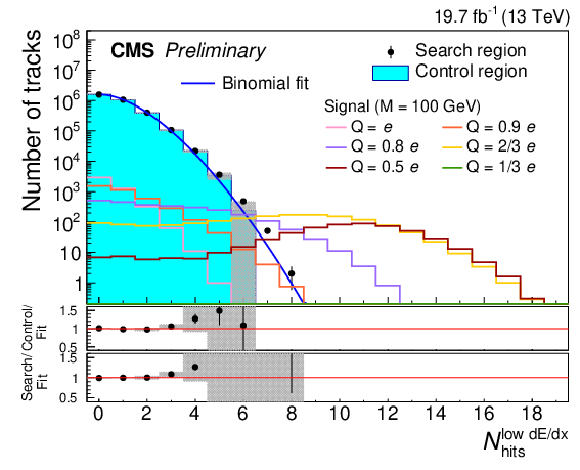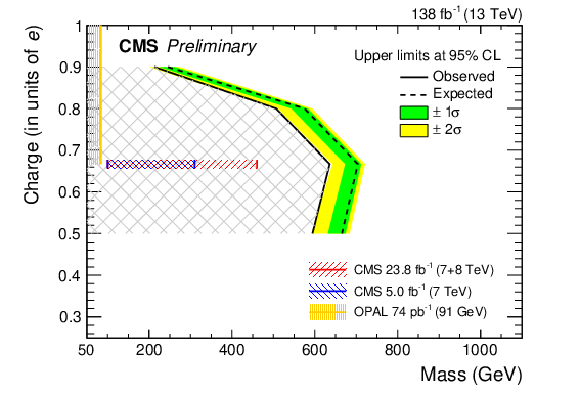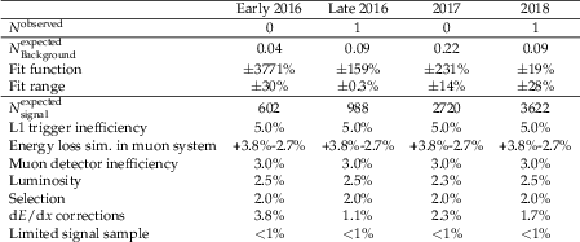

Compact Muon Solenoid
LHC, CERN
| CMS-PAS-EXO-19-006 | ||
| Search for fractionally charged particles in pp collisions at $ \sqrt{s}= $ 13 TeV | ||
| CMS Collaboration | ||
| 29 November 2022 | ||
| Abstract: Every known charged particle has an electric charge that is a multiple of 1/3e. In the absence of a mechanism to explain this quantization, particles with other charges may exist as well. In particular, only weak constraints have been set on the existence of free-propagating particles with charge below 1e and mass accessible at the LHC. A search is presented for fractionally charged particles using energy loss in the tracking detector as a key variable to suppress backgrounds. Using a data set corresponding to an integrated luminosity of 138 fb$^{-1}$ of proton-proton collisions collected at a center-of-mass energy of 13 TeV by the CMS experiment, masses up to 636 GeV and charges as low as 1/2e are excluded at 95% confidence level. | ||
|
Links:
CDS record (PDF) ;
CADI line (restricted) ;
These preliminary results are superseded in this paper, Submitted to PRL. The superseded preliminary plots can be found here. |
||
| Figures & Tables | Summary | Additional Figures | References | CMS Publications |
|---|
| Figures | |

png pdf |
Figure 1:
The $ \mathrm{d}E/\mathrm{d}x $ distribution for hits on candidate tracks in the control and search regions in 2018 data. |

png pdf |
Figure 2:
Distribution of $ N_{\text{hits}}^{\text{low dE/dx}} $ in the search and control regions for the early 2016 (top left), late 2016 (top right), 2017 (bottom left) and 2018 (bottom right) data sets. The vertical bars and the shaded area correspond to the statistical uncertainty in the search and the control region, respectively. The p-values of the fits $ \chi^{2} $ are 6% (early 2016), 78% (late 2016), 65% (2017) and 9% (2018). The top (bottom) lower panels show the ratio of the number of tracks observed in the control (search) region and the fit function. The vertical bars correspond to the uncertainty from statistical sources, while the shaded area gives the systematic uncertainty in the fit from the difference with the alternative function and the binomial fit starting at $ N_{\text{hits}}^{\text{low dE/dx}} = $ 1. |

png pdf |
Figure 2-a:
Distribution of $ N_{\text{hits}}^{\text{low dE/dx}} $ in the search and control regions for the early 2016 data set. The vertical bars and the shaded area correspond to the statistical uncertainty in the search and the control region, respectively. The p-value of the fit $ \chi^{2} $ is 6%. The top (bottom) lower panels show the ratio of the number of tracks observed in the control (search) region and the fit function. The vertical bars correspond to the uncertainty from statistical sources, while the shaded area gives the systematic uncertainty in the fit from the difference with the alternative function and the binomial fit starting at $ N_{\text{hits}}^{\text{low dE/dx}} = $ 1. |

png pdf |
Figure 2-b:
Distribution of $ N_{\text{hits}}^{\text{low dE/dx}} $ in the search and control regions for the late 2016 data set. The vertical bars and the shaded area correspond to the statistical uncertainty in the search and the control region, respectively. The p-value of the fit $ \chi^{2} $ is 78%. The top (bottom) lower panels show the ratio of the number of tracks observed in the control (search) region and the fit function. The vertical bars correspond to the uncertainty from statistical sources, while the shaded area gives the systematic uncertainty in the fit from the difference with the alternative function and the binomial fit starting at $ N_{\text{hits}}^{\text{low dE/dx}} = $ 1. |

png pdf |
Figure 2-c:
Distribution of $ N_{\text{hits}}^{\text{low dE/dx}} $ in the search and control regions for the 2017 data set. The vertical bars and the shaded area correspond to the statistical uncertainty in the search and the control region, respectively. The p-value of the fit $ \chi^{2} $ is 65%. The top (bottom) lower panels show the ratio of the number of tracks observed in the control (search) region and the fit function. The vertical bars correspond to the uncertainty from statistical sources, while the shaded area gives the systematic uncertainty in the fit from the difference with the alternative function and the binomial fit starting at $ N_{\text{hits}}^{\text{low dE/dx}} = $ 1. |

png pdf |
Figure 2-d:
Distribution of $ N_{\text{hits}}^{\text{low dE/dx}} $ in the search and control regions for the 2018 data set. The vertical bars and the shaded area correspond to the statistical uncertainty in the search and the control region, respectively. The p-value of the fit $ \chi^{2} $ is 9%. The top (bottom) lower panels show the ratio of the number of tracks observed in the control (search) region and the fit function. The vertical bars correspond to the uncertainty from statistical sources, while the shaded area gives the systematic uncertainty in the fit from the difference with the alternative function and the binomial fit starting at $ N_{\text{hits}}^{\text{low dE/dx}} = $ 1. |

png pdf |
Figure 3:
Exclusion region (hatched) at 95% CL in the FCP charge-mass plane for the considered signal model. The exclusion region extends down to a mass of 50 GeV, above which the background control region is free from signal. Previous exclusion from OPAL [10] is given for comparison. |
| Tables | |

png pdf |
Table 1:
Number of tracks observed, expected for background events, and expected for signal events, in the highest $ N_{\text{hits}}^{\text{low dE/dx}} $ bin, for each data set. The corresponding systematic uncertainties are also listed. The results for an FCP scenario at a mass of 100 GeV and a charge of 2/3e (i.e. the most sensitive scenario) is also shown. |
| Summary |
| In summary, we presented a search for fractionally charged particles using an integrated luminosity of 138 fb$^{-1}$ of pp collisions collected at $ \sqrt{s}= $ 13 TeV with the CMS detector. The key feature of low ionization energy in the CMS tracker detector is used to isolate a potential signal from the background. No significant deviation is observed in data with respect to the expected background. The existence of fractionally charged particles is excluded up to a mass of 636 GeV for a signal of charge $ Q = $ 2/3e. These are the best limits on this particular new-physics signature in the considered phase space. |
| Additional Figures | |

png pdf |
Additional Figure 1:
Exclusion region (hatched) at 95% CL in the FCP charge-mass plane for the considered signal model. Signal points at electric charges 0.9, 0.8, 2/3, 0.5 and 1/3$e$ are connected by straight lines to guide the eye. The existence of FCPs as described by the considered model is excluded in the mass range between 50 and 635 GeV (65 GeV) for a signal of electric charge $ Q = $ 2/3$e$ (1/3$e$). Previous exclusions from CMS [5,6] as well as OPAL [10] are given for comparison. |
| References | ||||
| 1 | B. Holdom | Two U(1)'s and Epsilon Charge Shifts | PLB 166 (1986) 196 | |
| 2 | S. A. Abel et al. | Kinetic Mixing of the Photon with Hidden U(1)s in String Phenomenology | JHEP 07 (2008) 124 | 0803.1449 |
| 3 | P. Langacker | The Physics of Heavy $ Z^\prime $ Gauge Bosons | Rev. Mod. Phys. 81 (2009) 1199 | 0801.1345 |
| 4 | D. E. Morrissey, D. Poland, and K. M. Zurek | Abelian Hidden Sectors at a GeV | JHEP 07 (2009) 050 | 0904.2567 |
| 5 | CMS Collaboration | Search for fractionally charged particles in pp collisions at $ \sqrt{s}= $ 7 TeV | PRD 87 (2013) 092008 | CMS-EXO-11-074 1210.2311 |
| 6 | CMS Collaboration | Searches for Long-Lived Charged Particles in pp Collisions at $ \sqrt{s} $ = 7 and 8 TeV | JHEP 07 (2013) 122 | CMS-EXO-12-026 1305.0491 |
| 7 | S. L. Dubovsky, D. S. Gorbunov, and G. I. Rubtsov | Narrowing the window for millicharged particles by CMB anisotropy | [Pisma Zh. Eksp. Teor. Fiz.79, 3] JETP Lett. 79 (2004) 1 |
hep-ph/0311189 |
| 8 | N. Vinyoles and H. Vogel | Minicharged Particles from the Sun: A Cutting-Edge Bound | JCAP 03 (2016) 002 | 1511.01122 |
| 9 | S. Davidson, S. Hannestad, and G. Raffelt | Updated bounds on millicharged particles | JHEP 05 (2000) 003 | hep-ph/0001179 |
| 10 | OPAL Collaboration | Search for heavy charged particles and for particles with anomalous charge in $ e^{+} e^{-} $ collisions at LEP | Z. Phys. C 67 (1995) 203 | |
| 11 | M. Staelens | Recent Results and Future Plans of the MoEDAL Experiment | MoEDAL Collaboration, in Meeting of the Division of Particles and Fields of the American Physical Society (DPF) Boston, 2019 | 1910.05772 |
| 12 | A. Haas, C. S. Hill, E. Izaguirre, and I. Yavin | Looking for milli-charged particles with a new experiment at the LHC | PLB 746 (2015) 117 | 1410.6816 |
| 13 | A. Ball et al. | A Letter of Intent to Install a milli-charged Particle Detector at LHC P5 | 1607.04669 | |
| 14 | A. Ball et al. | Search for millicharged particles in proton-proton collisions at $ \sqrt{s} = $ 13 TeV | 2005.06518 | |
| 15 | P.-K. Hu, A. Kusenko, and V. Takhistov | Dark Cosmic Rays | PLB 768 (2017) 18 | 1611.04599 |
| 16 | CMS Collaboration | The CMS experiment at the CERN LHC | JINST 3 (2008) S08004 | |
| 17 | CMS Collaboration | Description and performance of track and primary-vertex reconstruction with the CMS tracker | JINST 9 (2014) P10009 | CMS-TRK-11-001 1405.6569 |
| 18 | T. Sjöstrand et al. | An Introduction to PYTHIA 8.2 | Comput. Phys. Commun. 191 (2015) 159 | 1410.3012 |
| 19 | J. Alwall et al. | The automated computation of tree-level and next-to-leading order differential cross sections, and their matching to parton shower simulations | JHEP 07 (2014) 079 | 1405.0301 |
| 20 | NNPDF Collaboration | Parton distributions for the LHC Run II | JHEP 04 (2015) 040 | 1410.8849 |
| 21 | NNPDF Collaboration | Parton distributions from high-precision collider data | EPJC 77 (2017) 663 | 1706.00428 |
| 22 | CMS Collaboration | Event generator tunes obtained from underlying event and multiparton scattering measurements | EPJC 76 (2016) 155 | CMS-GEN-14-001 1512.00815 |
| 23 | CMS Collaboration | Investigations of the impact of the parton shower tuning in Pythia 8 in the modelling of $ \mathrm{t} \overline{\mathrm{t}} $ at $ \sqrt{s}= $ 8 and 13 TeV | CMS Physics Analysis Summary, 2016 CMS-PAS-TOP-16-021 |
CMS-PAS-TOP-16-021 |
| 24 | CMS Collaboration | Extraction and validation of a new set of CMS PYTHIA8 tunes from underlying-event measurements | EPJC 80 (2020) 4 | CMS-GEN-17-001 1903.12179 |
| 25 | GEANT4 Collaboration | GEANT 4---a simulation toolkit | NIM A 506 (2003) 250 | |
| 26 | CMS Collaboration | The CMS trigger system | JINST 12 (2017) P01020 | CMS-TRG-12-001 1609.02366 |
| 27 | CMS Collaboration | Performance of the CMS muon detector and muon reconstruction with proton-proton collisions at $ \sqrt{s}= $ 13 TeV | JINST 13 (2018) P06015 | CMS-MUO-16-001 1804.04528 |
| 28 | CMS Collaboration | The CMS Phase-1 Pixel Detector | in preparation, 2020 | |
| 29 | CMS Collaboration | Precision luminosity measurement in proton-proton collisions at $ \sqrt{s} = $ 13 TeV in 2015 and 2016 at CMS | EPJC 81 (2021) | CMS-LUM-17-003 2104.01927 |
| 30 | CMS Collaboration | CMS luminosity measurement for the 2017 data-taking period at $ \sqrt{s} = $ 13 TeV | CMS Physics Analysis Summary, 2018 CMS-PAS-LUM-17-004 |
CMS-PAS-LUM-17-004 |
| 31 | CMS Collaboration | CMS Luminosity Measurements for the 2018 Data Taking Period at $ \sqrt{s} = $ 13 TeV | CMS Physics Analysis Summary, 2018 CMS-PAS-LUM-18-002 |
CMS-PAS-LUM-18-002 |
| 32 | T. Junk | Confidence level computation for combining searches with small statistics | NIM A 434 (1999) 435 | hep-ex/9902006 |
| 33 | A. L. Read | Presentation of search results: The CL(s) technique | JPG 28 (2002) 2693 | |

|
Compact Muon Solenoid LHC, CERN |

|

|

|

|

|

|